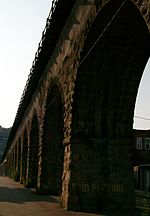Bishop Donahue Memorial High School
1955 establishments in West Virginia2017 disestablishments in West VirginiaBuildings and structures in Marshall County, West VirginiaCatholic secondary schools in West VirginiaEducation in Marshall County, West Virginia ... and 3 more
Educational institutions established in 1955Marist Brothers schoolsRoman Catholic Diocese of Wheeling-Charleston
Bishop Donahue Memorial High School was a private, Roman Catholic high school in McMechen, West Virginia. It was part of the Roman Catholic Diocese of Wheeling-Charleston. It was named after Bishop Patrick James Donahue (1849–1922), who served as the third Bishop of the Diocese of Wheeling from 1894 until his death in 1922. At the end of the 2016-2017 school year, Bishop Donahue High School closed. It was opened for 62 school years (1955 - 2017) and graduated 59 classes (1959 - 2017).
Excerpt from the Wikipedia article Bishop Donahue Memorial High School (License: CC BY-SA 3.0, Authors).Bishop Donahue Memorial High School
Garfield Street,
Geographical coordinates (GPS) Address Nearby Places Show on map
Geographical coordinates (GPS)
| Latitude | Longitude |
|---|---|
| N 39.9925 ° | E -80.730833333333 ° |
Address
Garfield Street
26040
West Virginia, United States
Open on Google Maps







